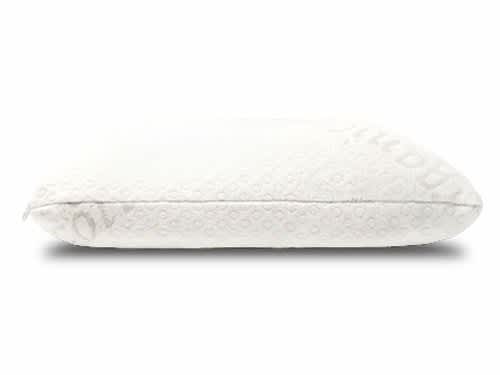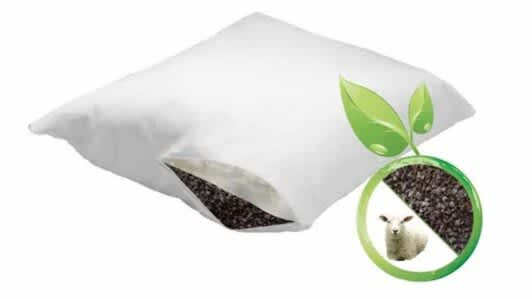On This Page
The Best Buckwheat Pillows
Our Top Picks
-
Best Overall
Sweet Zzz Buckwheat Pillow -
Best Value
The Futon Shop Organic Wool & Buckwheat Pillow
Best Overall
Highlights
Highlights
- Organic cotton covers
- OEKO-TEX Standard 100 certified for safety
- Contains 5 pounds of buckwheat hulls
Ideal For
- All sleeping positions
- Sleepers who want easy maintenance
- Those looking for a durable pillow
Full Details
Best Value
Highlights
Highlights
- Plush layer of GOTS-certified organic wool
- Made in San Francisco
- Materials are naturally flame- and dust mite-resistant
Ideal For
- All sleeping positions
- Those with allergies
- Eco-conscious shoppers
Full Details
How We Test Pillows
We test pillows against the same set of strict standards that we use for other pillow types, but we pay close attention to several factors that set different pillows apart. In addition to firmness, conforming, and ease of cleaning, we also measure breathability. Many sleepers choose specific materials for their cool feel. To determine how well a pillow regulates temperature, we use thermal sensors that measure heat retention and we try them ourselves too, taking notes on how warm or cool we think a pillow feels after use.
What Is a Buckwheat Pillow?
Also known as sobakawa pillows, buckwheat pillows originated in Japan more than 600 years ago. Since their origin, people have used buckwheat pillows to achieve zukansokunetsu, which means a cool head and warm feet.
Buckwheat is a flowering plant that produces grain. When harvesters process buckwheat for consumption, the hard outer shells, known as hulls, are often left over. Many manufacturers use these hulls to design supportive pillows for hot sleepers.
Buckwheat pillows are known for their beanbag-like quality. The hulls easily move around inside the pillow, conforming to the sleeper’s upper body. This level of moldability is integral to alleviating neck and shoulder pain. Most buckwheat pillows allow for the level of fill to be adjusted so sleepers can add and remove hulls according to their needs.
We’ll dive deeper into the pros and cons of buckwheat pillows, who should choose a buckwheat pillow, and how to keep them clean.
If you’re a combination sleeper or you want a versatile pillow, buckwheat is a great option. Lots of models open up so that you can add or remove fill to get the perfect loft level.
Are Buckwheat Pillows Organic?
Many buckwheat pillows contain organic hulls. Buckwheat hulls are plant products that are natural, compostable, and biodegradable. The growing and manufacturing processes are also eco-friendly in that buckwheat is often grown without fertilizers and pesticides and the hulls are cleaned and dried without additional chemicals.
Some pillow covers are made of organic materials such as certified organic cotton or wool, while others contain synthetic materials or blends.
Buckwheat Pillow Sizes
Buckwheat pillows come in many sizes, which vary by brand and model. Common sizes include standard, queen, and king. Buckwheat pillows also come in the smaller Japanese/traditional sobakawa size. Many manufacturers also design specialty shapes and sizes, including neck and body pillows.
| Size | Average Dimensions |
| Japanese / Traditional Sobakawa | 14” x 20” |
| Standard | 20” x 26” |
| Queen | 20” x 30” |
| King | 20” x 36” |
Are Buckwheat Pillows Comfortable?
Buckwheat pillows are naturally firm and have a unique feel. Those who favor firm pillows will find buckwheat pillows comfortable, while those who enjoy a soft, plush pillow may not like the hardness of the hulls or the lack of cushioning.
Sleepers who like buckwheat pillows often cite their moldability. These pillows seamlessly conform to the head, neck, and shoulders, promoting neutral spinal alignment for those who sleep on their side or back.
Pros and Cons of Buckwheat Pillows
Consider the pros and cons of buckwheat pillows to determine if it’s the right pillow type for your sleeping position and preferences.
Advantages
- Adjustable loft: Sleepers can often add or remove buckwheat hulls to adjust the pillow’s loft, making it accommodating for a variety of sleeping positions and preferences. For instance, side sleepers who typically require higher lofts can add hulls, while back sleepers can remove hulls to achieve a low or medium loft.
- Support: Due to the hardness of the hulls, buckwheat pillows are firm and retain their shape under the weight of the head. The hulls can be adjusted to the needs of different sleep positions, providing sufficient support for most side and back sleepers.
- Natural cooling: Buckwheat hulls allow for air to flow naturally through the pillow, making them great for hot sleepers. This is one of the major benefits of a buckwheat pillow, as the natural material doesn’t trap heat like other pillow types.
- Moldability: Buckwheat hulls easily move inside the pillow to contour the head and neck, resulting in a feeling similar to sitting on a beanbag. The moldable pillow creates a comfortable and customizable shape to support the head, neck, and shoulders.
- Natural materials: Buckwheat hulls are a natural material that can be composted at the end of its lifespan. For models with natural materials used for the cover, as well, this makes for a very eco-friendly pillow option.
- Durability: The outer shell of buckwheat seeds are naturally hard and durable, enabling a longer lifespan compared to softer pillows with less shape retention. The longevity may even offset the higher cost often associated with buckwheat pillows.
Disadvantages
- Heavy: Buckwheat pillows can weigh as much as 10 to 12 pounds. This is heavier than most other pillow types, which usually weigh a few pounds or less. Some sleepers may not enjoy the additional pillow weight, especially if they like to travel with their personal pillow.
- Noisy: Buckwheat hulls are hard and, as they move around, they move against one another and make sounds. Similar to beanbags, buckwheat pillows create a rustling noise when lying on or adjusting them. Some sleepers may find the noise distracting or disruptive.
- Firm: Buckwheat pillows are firm to extra firm. Some sleepers, especially those who prefer a plush pillow that allows their head to sink in, may not like such a hard surface to rest their head on. Stomach sleepers, for instance, generally need a soft to medium soft pillow for optimal spinal alignment, if they use one at all.
- Clumpy: Over time, buckwheat hulls can clump together and flatten, requiring sleepers to regularly adjust their pillow. Sleepers may need to fluff the pillow frequently or eventually replace the hulls to fix the issue.
- Scent: Because a buckwheat pillow’s fill comes from a plant, it emits a natural, earthy scent. This odor is more prevalent in newer pillows and typically goes away with time. Some sleepers love the smell and find it relaxing, while others dislike it or feel that it’s overpowering.
- Price: Buckwheat pillows generally have a higher price tag than other pillow types, especially if the buckwheat pillow has one or more organic certifications. Although the upfront costs may seem high, they’re typically offset by the pillow’s excellent durability and longer lifespan.
Even though buckwheat pillows can be on the pricier side, I think they’re really worth it if you’re looking for an option that’s going to last a long time. They’re super durable and you can replace the buckwheat hulls when you need a refresh.
Explore More Pillows
If you’re looking for a particular type of pillow, check out our other guides below.
More Pillows by Fill
- Best Bamboo Pillows
- Best Down Alternative Pillows
- Best Down Pillows
- Best Feather Pillows
- Best Latex Pillows
- Best Memory Foam Pillows
- Best Polyester Pillows
Who Should Choose a Buckwheat Pillow?
A variety of sleepers can benefit from choosing a buckwheat pillow. Those who sleep on their back or sides, prefer substantial firmness, or need strong support for their upper body tend to like buckwheat pillows.
How to Clean a Buckwheat Pillow
Many buckwheat pillows have covers that are machine washable. Buckwheat hulls cannot be cleaned, so sleepers should remove the hulls and place them in a separate container prior to washing the cover.
Replacing Buckwheat Hulls
Sleepers can refresh their pillow by replacing the buckwheat hulls around once every three years. You can purchase buckwheat hulls through Amazon, pillow manufacturers, or seed companies. Replacing the fill requires approximately 10 to 12 pounds of hulls, which can range in price but starts around $50. When choosing replacement hulls, you may want to consider several factors, including where the hulls are grown and whether or not they’re organic.
Are There Bugs in Buckwheat Pillows?
Buckwheat pillows do not attract bugs. Buckwheat food products, such as flour, contain insect-attracting sustenance. However, buckwheat pillows only contain empty outer shells, meaning they do not contain the substance that attracts insects.


